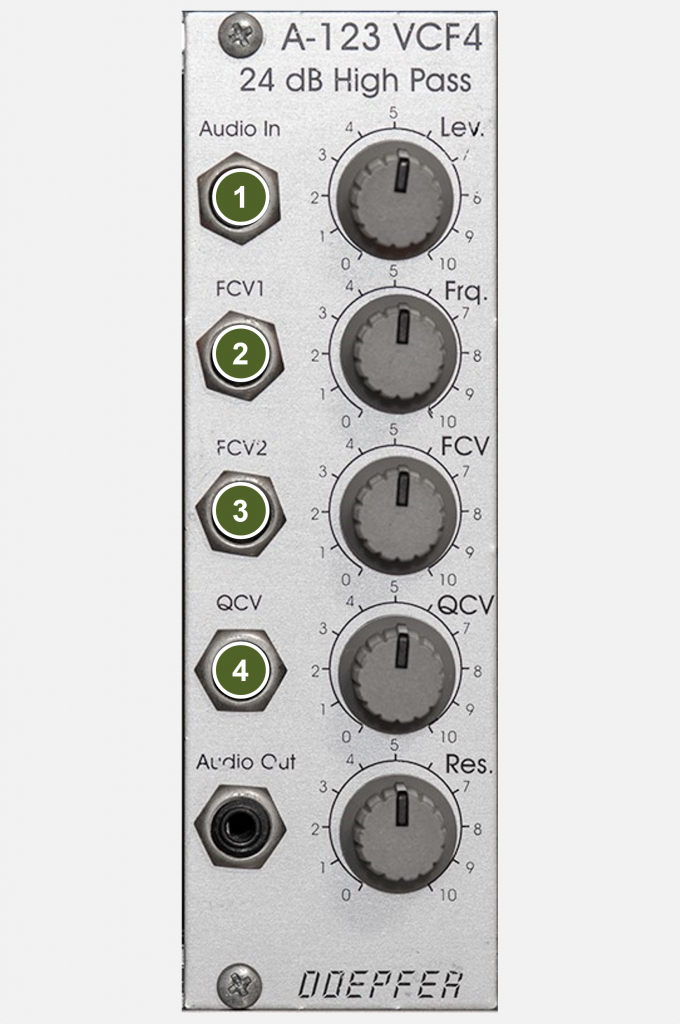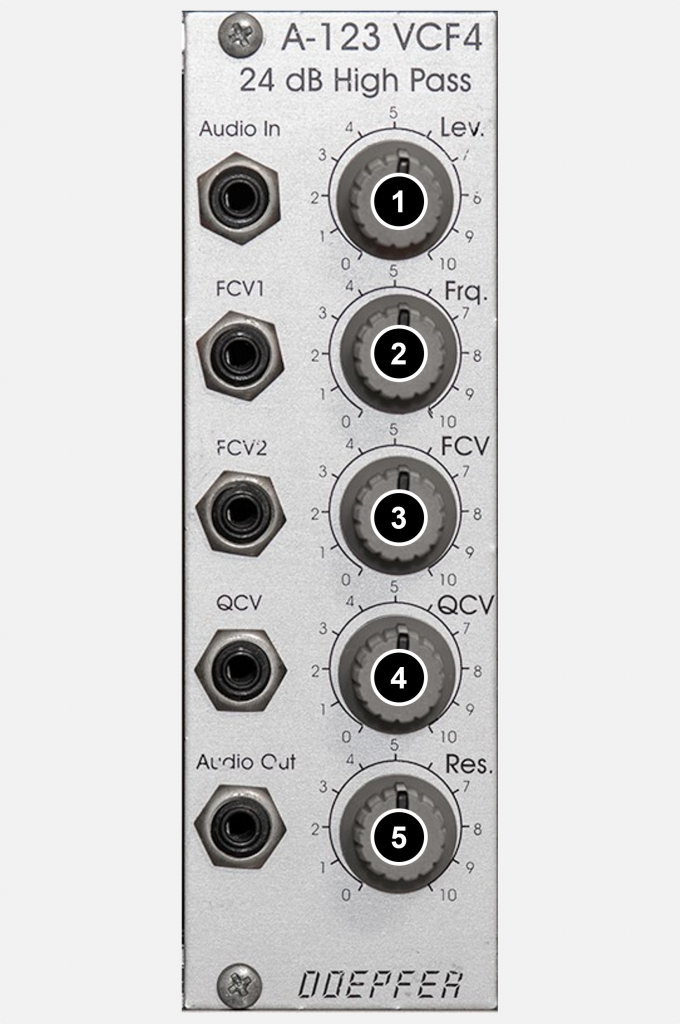The module is no longer in production.
Of all the modules that are no longer in production for one reason or another (most often it was the unavailability of certain Curtis chips, like the CEM3320 here), the A-123 filter was probably the most difficult to replace. There were simply no other 24dB high-pass filters, neither from Doepfer nor from other manufacturers.
In the meantime, however, Doepfer has brought a successor onto the market with the A-123-2, which is based on a replica of the CEM3320 and has a significantly expanded range of functions compared to the original module.
User interface
Inputs:

- Audio In: Audio input.
- FCV1: Control voltage input for the cutoff-frequency (without attenuator).
- FCV2: Control voltage input for the corner frequency (with attenuator “FCV”).
- QCV: Control voltage input for the resonance of the filter (with attenuator “QCV”).
Outputs:

- Audio Out: Audio output of the filter.
Controls:

- Lev.: Attenuator for the audio input.
- Frq.: Controller for the cutoff-frequency.
- FCV: Attenuator for the control voltage input “FCV2” (for the cutoff-frequency of the filter).
- QCV: Attenuator for the control voltage input “QCV” (for the resonance of the filter).
- Res.: Controller for the resonance of the filter.
Possible uses
It seems a bit paradoxical at first: A high-pass filter (with resonance!) can of course be used to “thin out” a signal, but at the same time it can also be used to “thicken” a signal via the self-oscillation of the filter – if the cut-off frequency of the filter is in a suitable frequency range.
For this purpose, a relatively high resonance is set, the cutoff-frequency should not be too high and the modulation of the cutoff-frequency should remain moderate.
Sound examples
-
A-123, A-123-2 / Comparison of versions
Since the A-123-2 is the successor to the (rarely available) A-123, the question arises as to whether the two modules differ significantly. First of all: The differences seem to me to be rather marginal and probably come from different fine-tuning of the modules.
As input material I use again 3 A-110-1 VCOs with their sawtooth oscillations, one of them is transposed 1 octave down. The mix goes equally into the A-123 and A-123-2 filters. The self-resonance of both filters was previously tuned to the same pitch. Both filters and the downstream A-132-3 VCAs are modulated by the same A-140 ADSR.
We hear the A-123 filter on the left and the A-123-2 filter on the right.
- I start with an input level of 5 (which shouldn’t distort yet) and a resonance (or “Q” on the A-123-2) of 0. While a simple arpeggio is playing, I manually drive the filter cutoff frequency from bottom to top and back – voltage controlled for both filters so that the cutoff frequencies are roughly parallel.
- In the second pass, the input level is 5 again, but the resonance is increased to 5. Again the manual filter sweep from bottom to top and back.
- In the third pass, the input level is still at 5, but the resonance is increased to 10 – same filter sweep as before.
- Fourth pass: input level is now 10, resonance reduced to 0 again, same filter sweep as before.
- Fifth pass: input level 10, resonance 5, filter sweep.
- Sixth pass: input level 10, resonance 10, filter sweep.
- Finally, I run the filter sweep again with resonance 10, but without an input signal (level = 0) to demonstrate pure natural resonance.
Left: A-123, right: A-123-2. The 24 dB output of the A-123-2 is used for comparison.
Alternatives
The most obvious alternative is the successor A-123-2, which offers additional outputs for 18, 12 and 6 dB.
Otherwise, a 12dB high-pass filter will normally be sufficient, especially since there are also models with the possibility of self-oscillation, such as the A-121-2, which the A-123 naturally also mastered. In order to reduce the difference in sound between 24dB and 12dB high pass, you can of course use two A-121-2 switched in series. However, then we have a lot of material “in the running” and must very finely adjust the cutoff-frequencies and other parameters of the two filters, not to mention multiples for parallel control via control voltage.
Technical specifications
| Width | 8 HP |
| Depth | 50 mm |
| Power requirements | 20 mA (+12V) / -20 mA (-12V) |
